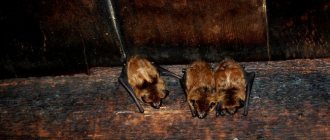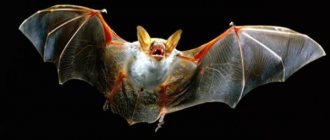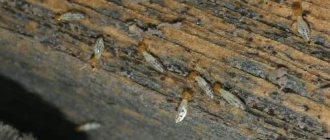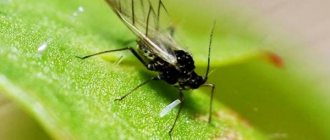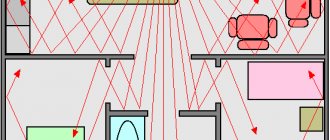About bats
To begin with, there are too many rumors, speculations and artistic images around these animals.
Here are the most common:
- feed on flesh
- drink blood
- bite and transmit infection.
Also, their appearance, of course, evokes emotion in few people. That is why the appearance of bats near a person does not make people happy at all. The reality is that bats living in the European part of Russia are harmless and safe creatures for humans.
What worries us all first is what they eat. So, their main diet is insects, which, by the way, especially bother us, namely mosquitoes, flies, moths, etc. A rare exception in the diet of bats is frogs. As you understand, to some extent, they are even assistants.
There are, of course, species that still feed on fruits. Such “neighbors” can already cause damage to your fruit plantings.
But, as a result, bats definitely won’t eat people and drink their blood.
Naturally, bats still pose a danger to people. Animal excrement is saturated with fungal vapors, which, when entering the human lungs, can cause serious illness. Bat excrement, also known as guano, has a pungent odor, oblong shape, and color from earthy gray to black.
But it is worth noting that this fungus is also present in bird excrement. So, of course, there is a chance of inhaling it from bat droppings, so you must follow a number of rules, which we will describe below. Biting is absolutely not a typical behavior for bats. After all, even if an animal is sick with rabies, it would rather become lethargic and apathetic than rush at people and animals. But if a person is bitten or scratched by a bat, it is better to immediately consult a doctor for vaccination and treatment.
Also, bats can damage the attic space, or the construction materials that are around.
Well, and most importantly, they can frighten the residents of the house with their unexpected appearance.
Although we now understand that they are not particularly dangerous, such a “neighborhood” is unpleasant in any case, to some extent has its consequences, and it is better to get rid of it in a humane way.
The danger of “neighborhood” with a person
Bats are difficult to classify as pests. They feed on insects and live in hard-to-reach places. Flyers have virtually no contact with humans, but at the same time bring significant benefits. By destroying insects, they protect crops from attack by pests. And by eating midges and mosquitoes, they protect people from unpleasant and painful bites.
But if these valuable “helpers” settle next to the apartment, they can seriously disturb not only the peace, but also cause significant harm.
Lack of silence. Night “guests” make a rather unpleasant squeak. The flapping of the wings is accompanied by characteristic claps. All these rustling noises occur at night, so you will have to forget about a restful sleep for a while. Chance of being bitten. Bats practically do not bite. But if you disturb the colony, irritate the animal, or unsuccessfully catch an individual that accidentally flew into your house, you may feel a very dangerous bite on yourself. Mice do not bite painfully because their saliva contains an analgesic component. However, the bite can lead to serious problems. Spread of infection. Bats can become carriers of many diseases dangerous to humans. They themselves do not suffer from these infections, since they are able to increase their body temperature, thereby activating the immune system. Doctors warn that uninvited “neighbors” can infect a person with Ebola fever, SARS, Marburg virus, hemorrhagic fever, rabies and other pathologies. Litter. Bat feces are contaminated with histoplasmosis. The droppings emit vapors that penetrate the human body. The fungus can lead to the development of serious pathologies of the respiratory system.
Human activity has led to a rapid decline in the bat population. Therefore, many species were listed in the Red Book and are protected by law.
Features of bats
Bats belong to the order Chiroptera. But they are not “relatives” of ordinary mice. They are considered primates. These animals are nocturnal, despite their rather poor eyesight, and are perfectly oriented in the dark. Bats emit ultrasound, which helps to accurately distinguish small stones from insects over long distances. It is thanks to echolocation that they move in the dark. Below are some more interesting facts about bats.
- Life cycle. Bats live longer than dogs. On average, the lifespan of a “mystical” animal is 25-30 years.
- Dimensions. Bats, depending on the species, may have different parameters. Some individuals do not exceed the dimensions of a bumblebee in size. But there are also real giants, whose wingspan is 2 m.
- Ancient inhabitants. According to archaeological excavations, bats inhabited our planet approximately 55 million years ago. These animals have been practically untouched by evolution. Their remains are no different from modern individuals.
- Body temperature. Can vary from −7ºС to +48ºС.
- State of numbness. In winter, bats, deprived of the opportunity to get their own food, prefer to do nothing. Goes into a sleep state. This numbness can last up to eight months. The animal independently slows down metabolic processes and lowers body temperature. In the event of severe frosts, they can turn into real “icicles”, but with the arrival of warmth they thaw and continue their life activity again.
Bats breed once a year. Babies are conceived during wintering. The offspring are never numerous. Usually in the summer only one mouse is born. Sometimes two cubs may be born.
Area
These animals choose secluded, dark and completely safe shelters during the daytime. In the wild, they settle in rock crevices, caves, abandoned burrows and hollows, on the slopes of dunes, even in the recesses of walls.
Human activity is leading to the destruction of natural bat habitats. The animals are forced to look for new shelters. They quickly adapt to the new environment and settle next to humans. The winged ones inhabit abandoned adits and mines, attics, cellars, cellars and forgotten bell towers. Uninvited guests can be found in haystacks and on balconies.
Bats are unable to take off from the ground because they have rather large wings. Therefore, they choose places to rest from which they can throw themselves headfirst.
Nutrition and main types
Despite the vampirism attributed to them, most species are quite peaceful and vegetarians. However, not all. Food preferences depend on the type of mouse. More detailed information is provided in the table.
Table - Types of bats
| Species name | Description | What do they eat? |
| White (tailless) | — They have a length of up to 4.5 cm, small ears and an unusual nose; — live in Honduras, Panama, Costa Rica, Nicaragua; — settle in the huge leaves of heliconia, forming a family of 5-6 individuals | Fruits |
| Vechernitsy | — Inhabit North Africa and European countries; - have large sizes (length 10-50 cm); — fly at a speed of 60 km/h; - live in deciduous forests | — Beetles; - butterflies; - small songbirds |
| Fruit (dogs or foxes) | — Live in the forests of Malaysia, the Philippines, Laos, Vietnam; - distinguished by an elongated muzzle; - the body reaches 42 cm, and the wingspan is 1.7-2 m; - settle in trees; - live in huge colonies | - Bananas; - papaya; - grapes; - coconuts |
| Smooth-nosed | - They have a smooth muzzle without any cartilaginous growths; - found in all countries where woody vegetation grows | — Insects; - fish |
| Ushany | - They have large ears; - distinguished by short and wide wings; - the body reaches a length of 5-6 cm; - found in Europe, Asia, North Africa | — Beetles; - butterflies; - mosquitoes |
| Horseshoe bats | - They have a cartilaginous growth in the area of the nose that resembles a horseshoe; — take off immediately after sunset; - hunt only in the first half of the night; - live in the Caucasus | Insects |
| Nightwomen | — Inhabit all countries and continents, except the Arctic; - fly out to hunt in complete darkness; - have a high degree of adaptability, can live in any conditions; - fly calmly and slowly | By night insects |
| Vampire | - They have weak echolocation; - have developed hearing; - have infrared receptors; - inhabit only South and Central America | Blood of birds and animals (sometimes they can drink blood from a sleeping or exhausted person) |
Reasons for appearance
In nature, to create places for their settlement, bats choose dry, dark, high-altitude places, natural depressions - caves, hollows, etc.
Human dwellings, firstly, attract bats with high altitude - this is the reason for the sudden appearance of bats in the attics of residential high-rise buildings, balconies, etc.
Private houses are also tempting - bats choose non-residential premises and spaces because they are dark, dry and quiet - attics of houses, barns, chimneys, etc.
In nature, bats tend to lead an active lifestyle from spring to autumn. Then, the animals either fly away to warm countries or hibernate.
But, since a person’s home is, first of all, an approximately constant temperature, this is exactly what they like, and bats on the roof of a house can continue to remain, multiplying their offspring, without changing place.
That is, they appear in our houses and on roofs only because they are looking for a reliable place for breeding offspring and further life.
And, it should be remembered that they arrive in whole colonies at once, and not in separate “pairs”.
How to understand that bats have settled under the roof
- The first and most obvious thing is that you will see them . Bats are nocturnal and sleep during the day. You can see them in the evening or at night, that is, just when they begin to fly out for food or to drink.
- You will hear them . It is at night that bats squeak, scratch, and rustle, which can disturb the peace of people. Since bats can penetrate into a gap of about 1.5 cm, bats can even live under the façade cladding.
- excrement emit an unpleasant odor, which, in addition to the usual discomfort, can also pose a threat, which we mentioned above. Besides the smell, the amount of droppings is always very large, so when looking for bats, the first thing you will see is a large amount of droppings.
Why are bats dangerous?
Based on the characteristics of the diet of bats, it is difficult to classify them as a pest. After all, the animal mainly feasts on those insects that harm crops and gardens. In this regard, bats even benefit summer residents and gardeners.
But these mammals also have negative factors that can be called dangerous:
- Smell and dirt . Bats actively fill their habitat with excrement, which depletes the stench.
- Carrier of infections . Bats are carriers of many dangerous infectious diseases.
- Allergy . Animal feces contain a lot of pathogenic microorganisms that provoke the development of serious allergic reactions. And constantly inhaled air containing microparticles of bat waste can cause histoplasmosis, a lung infection.
- Damage to home . Mice, having settled in the attics of houses, can chew through the waterproofing and spoil the insulation.
- If bitten, there is a risk of contracting rabies.
Neighborhood dangers
Aggressive bat
The unpleasant coexistence with the bat colony is due to the interference it creates. People who are faced with the unauthorized colonization of bats make complaints:
- to constant noise - night activity and fussing interferes with sleep, scares children;
- unpleasant odors and dirt - waste products are scattered under permanent habitats, emitting a disgusting aroma;
- unsanitary conditions - animals are carriers of infections and viruses, including those dangerous to humans; their droppings contain many pathogens and parasites;
- roof damage - animals gnaw holes in the insulation and waterproofing of the insulation; their activity requires constant repair of the roof.
The main danger when encountering blood-sucking bats is bites. Automatic protective reflexes of animals lead to infection of people; in Russia, between May and September, they spread rabies. In other species of animals, problems are caused by droppings, as the main transmitter of fungal infections.
Important! Epidemiologists advise cleaning rooms from traces of bats' activity using gloves and a respirator. After treatment, all clothing is disinfected and thoroughly ironed.
How to get rid of bats
There are several methods for removing bats from your home, but in any case, you should know how to do it correctly. Some countries have laws aimed at protecting bats from extermination. There is also a certain period when getting rid of animals is not recommended. This should not be done in the cold season - in winter bats hibernate, all metabolic processes in the body slow down, so the animals may die.
Bats can even be useful. For example, gardeners, summer residents.
After the birth of the offspring, it is impossible to drive away the adults, since the cubs will be doomed to a painful death by starvation. In addition, dead animals can cause an unpleasant odor and the spread of infection. Therefore, the procedure is carried out before their birth or after the feeding stage. Poisoning and killing bats is strictly prohibited, so the methods of control presented below are the most humane and effective.
It is prohibited to remove a bat using poisons and chemicals.
Prevention
To prevent the infestation of bats, you must follow simple rules
Experts focus on the following points:
- space under the roof - even small cracks can serve as an entrance for the compact bodies of animals;
- air ducts and ventilation systems are covered with thin meshes or grilles blocking the passage;
- in areas of possible settlement, hang foil, tins - anything that creates noise during air circulation;
- lighting - animals do not like places where sunlight freely penetrates.
It is better not to use chemicals in aerosols or baits - most bats are protected by law, and their destruction will lead to large fines. You can find out about permitted methods at your local sanitary and epidemiological station. If there are no results in expelling a flock of bats on your own, you can apply for a team specializing in this issue.
The best season for clearing your home of animals is autumn. In winter they hibernate, and in spring and summer they reproduce. Colonies consist of females raising their young. Attempts to breed mice at this time will lead to the death of the young.
Effective methods of control
There are many options explaining how to get rid of bats in the country. Choose a control method based on the simplicity of the method and the number of individuals living in the country.
Chemicals
The use of such products is not recommended. Remember that bats are protected by law and it is better not to destroy them. Bats can also get trapped in a crack and die in a hard-to-reach place, emitting a foul odor as they decompose.
Therefore, when choosing a pesticide, give preference to aerosols. For example, 876 4-Pack BatRepellent, which includes peppermint. The product is sprayed on the habitats of bats (strictly in their absence). The smell of chemicals will scare away the animals.
Use chemicals only in non-residential areas where there are no pets. When working with drugs, do not forget about personal protective measures (masks and gloves).
Repellers
To find out how to get rid of bats in your country house, consider using special devices - ultrasonic repellers. This is a safe and effective method. When operating, the repeller emits ultrasonic waves with a frequency of 35-60 kHz. They are not detected by humans and are harmless to them. But mice are sensitive to radiation and cannot tolerate it.
Using the device is simple - it is connected to a power outlet and the operating mode is set. After 1.5-2 weeks, the bats will leave their homes.
Among the most effective repellers are the following:
| Name | Description | Features of work |
| Tornado-200 | safe for humans and pets, operates from a 12 V voltage source | the ability to change vibrations prevents mice from becoming accustomed to ultrasound, the device operates within a radius of 200 m |
| Yastreb-300 | operates from a 220 V power source and requires the presence of an outlet in the house | range 300 m |
| Weitech-0300 | There is a mode for switching the oscillation frequency, it is also effective against ordinary rodent pests, it requires a voltage source of 220 V | effective in operation and expels mice in 10-12 days |
| Grad A-1000 PRO | equipped not only with ultrasound, but also with the effect of light flashes, which increases its efficiency, operates from a 220 V current source | has 4 operating modes and operates within a radius of 100 m |
In rare cases, ultrasonic repellers can trigger migraines in people with high sensitivity. Therefore, it is better not to stay within the range of the device for a long time.
Traditional methods
Study time-tested folk methods that explain how to get rid of bats in the country.
What means do you use to fight bats? Folk repellents
All these methods are absolutely safe and do not require material costs:
- Water . Chiropterans do not like humidity and will never settle in damp places. To expel mice, you need to spray their holes with water daily.
- Naphthalene . The animals have an excellent sense of smell and cannot tolerate strong odors, which include naphthalene. In order to combat uninvited guests, mothballs or pieces are laid out in their habitats (they are first placed in gauze bags).
- Light . Chiropterans will never return to their burrows unless it is dark. Place several powerful light sources in such a way as to illuminate the mice’s hiding places, and after 2-3 days the animals will leave this area.
- Polyurethane foam . It is needed to tightly seal all the cracks possible for penetration. But be sure to make sure that there are no animals in the holes, otherwise it will be extremely difficult to get rid of the stench later if the mice die in closed places.
- Smoker . Chiropterans cannot tolerate the smell of smoke. To smoke animals from your favorite territory, use a smoker for 2-3 days.
- Fans . Try using a fan as well, directing the air flow into the mouse den.
- Loud sounds . Although this method has not been proven to work, try scaring away a family of mice with the sounds of loud music.
Expert opinion Mityuk Stefania Bogdanovna If all methods have been tried, but stubborn bats do not bother to leave their homes, contact specialists. Professionals will explain how to get rid of bats in your dacha and help you with this. SES representatives have all modern equipment. They will quickly and reliably get rid of bats.
Preparation
Getting bats out from under your roof is a serious process and requires advance preparation. First of all, you need to prepare yourself. Here are some important rules that MUST be followed.
| Get dressed You need to wear thick clothing that will cover your entire body. In your arms be sure to wear thick gloves. On the head - thick hat. Bats that are frightened and disturbed may accidentally scratch or bite a person. |
| You must wear a respirator on your face Animal feces emit a pungent and unpleasant odor, plus, remember about harmful fumes. Be sure to wear protective (preferably construction) goggles on your eyes |
Method one - observational and handicraft
During twilight and night time, look for areas where bats enter the attic.
When you see that the mice have flown away to hunt, use any available methods to seal the entry points. Depending on the hole, you can use boards, tape, etc. It is better to use polyurethane foam later.
Remember, bats hunt once every few days. Therefore, the next day, open the entry point so that those who have not yet flown out will fly out.
After repeating this procedure for a week, making sure that now all the bats have definitely flown out, you can seal the holes more seriously - with polyurethane foam, sealant, etc.
Method two - natural and safe
There are also longer options, which may not be entirely effective, but they are safe.
Treatment with water, light and wind.
| For this method, you need to come to the bats during the day , when they are all together and sleeping. As we said above, bats prefer dry and dark places. You can water the animals with water from a hose with a diffuser nozzle (in this case, you can flood the attic), or simply spray them with water from a spray bottle. They won't like it and will fly away. |
| Also, we remember that bats do not like bright light. By directing a source of bright light at the attic inhabitants and leaving it there for a couple of nights , you can encourage the bats to fly away. |
| This method is also “daytime”. o leave a fan turned on and aimed directly at the bats. Theoretically, they won't like it and will fly away. |
The three methods listed above are good, but the likelihood that the bats will not return is not very high.
Method three - smoking and smelling
If bats are not in sight, or for some reason there is no desire or opportunity to waste electricity, water and time on these methods, there are still options.
| To literally smoke bats out from under the roof, smokers are used. If you don’t have a smoker, then an iron can will do, in which you will start a fire. Follow fire safety rules! The premises are treated with smoke over several days. The room fills with smoke and the bats fly away. However, the smoke clears quickly and the bats may return. And, it is important not to overdo it with the amount of smoke, otherwise people’s health will be at risk. |
| We use this method and do it at night, when there are no bats. Another well-known folk method of fighting bats is naphthalene. Sold in specialized departments. Mothballs can be in balls, tablets, flakes, bags and even sticks. Naphthalene, if it is in crumbly form, is sorted into bags (or we take ready-made bags of mothballs) and hung in places where bats gather. The procedure is repeated several times. The bags are changed once every 2 days because the smell weakens over time. Bats cannot stand the smell of mothballs and will fly away. BE CAREFUL! Naphthalene has a very pungent odor and you can only work with it in a respirator, and certainly not hang it in residential areas. |
Method four - dubious and controversial
There is information that special sprays and ultrasonic repellers for rodents are also used. But the effectiveness of these methods is also not 100% guaranteed.
| Sprays are purchased in specialized departments. It is prohibited to use sprays with toxic ingredients. The main idea is to drive away the bats, not kill them. The spray is sprayed during the ABSENCE of bats. Upon their return, a sharp, unpleasant smell will “wait” for them and they will fly away. |
| Ultrasonic repellers emit waves at frequencies inaudible to the human ear. That is, theoretically, bats and other rodents hear them, experience discomfort and leave. For humans and pets, this device is absolutely safe and invisible. Convenient if the habitat of bats has not been identified or is difficult to access. The device can work around the clock. |
Chemical methods of control
This method involves the use of special chemicals aimed at repelling bats. They should be used when animals leave their home in search of food. When choosing products, they rely on their ease of use, the number of mice living in the attic or barn, and the price.
- Special repellents. Animal habitats and openings through which they enter the room are treated with aerosols.
- Mothballs. The smell of mothballs repels bats, and over time they leave their favorite place. Since the smell dissipates over time, the procedure should be repeated.
Bats are extremely sensitive to its intrusive odor.
Important! Naphthalene is a hazard class 4 chemical whose vapors pose a threat to human health. The placement of this chemical in residential areas is prohibited.
Naphthalene can be a real help in the fight against bats.
Let's localize the problem
The first step is to find out where the animal is hiding. It is much easier and safer for all parties to organize a search during the daytime, when the pest is sleeping. First of all, it is worth inspecting dark places where daylight does not penetrate, for example, boxes or other utensils in the attic or closet.
Once bats enter a house, they most often cling to:
- curtains;
- cabinet furniture (walls made of fiberboard);
- branched and overgrown house plants;
- outerwear on a hanger;
- interior items.
Mice prefer dark-colored surfaces, creating a camouflage effect. That is, they will not linger on a white curtain or a bright coat.
Traditional methods of repelling bats
Traditional methods are less effective and are observed only after some time, but it is still worth a try.
- Additional lighting. Bright light discourages nocturnal creatures, so you can install lamps and leave the light on at night.
- Water. Since bats prefer only warm and dry places, you can water the room within reasonable limits so as not to damage the property. Dampness will definitely discourage guests. In addition, you can direct a stream of water directly at the animals, then they will certainly fly away, but they may soon return.
- Spraying smoke. To do this, you need to light a fire in a tin can, and then smoke out the animals using smoke. This procedure will have to be carried out over several days.
- Use of a fan. The disadvantage of this method is that it will only work if the air flow is directed directly at the animals.
Note! Due to the low effectiveness of these methods, it is recommended to use them as additional means.
Application of electrical appliances
Particularly popular are special electrical devices that affect bats using ultrasound. Sound waves of variable frequency through the hearing organs have an effect on the nervous system of animals, so they leave their habitats. The effect does not occur immediately, it usually takes two or three weeks.
The ultrasonic bat repeller acts quite humanely towards the animals.
The devices differ in some characteristics:
- by purpose: for animals, insects or universal;
- by installation location: indoors and outdoors;
- by mounting method: stationary and wall-mounted;
- by impact: with different frequencies.
- according to the zone (area) of the device.
A device that emits ultrasound waves repels critters from the attic and prevents them from returning.
Important! Such devices are completely safe for people, since humans are not sensitive to sound waves in this range. But if you have pets, you should remember that the effect of the device will also apply to them. It is recommended to isolate pets during installation of the device.
May-July is the breeding season for bats, so it is recommended to get rid of bat colonies either before May or after July.
Traps and repellers
- Mousetrap. You can, of course, set mousetraps. If the device is of high quality and sensitive, then the effect will be good. But there are several disadvantages here too. An ordinary person will hardly be able to distinguish a high-quality trap from a cheap fake. And then you will have to buy different models to identify the most effective one. If the trap is not lethal, the live mouse must be placed somewhere. And many people are very squeamish, which is true of mice, because they are carriers of diseases. In addition, traps will have to be constantly checked for the presence of bait and charged if the mousetrap runs out of charge, meaning the rodent managed to escape. Recently, sticky traps have become popular - these are small squares of thick cardboard coated with a very sticky substance, the mouse simply sticks to it. But it is disposable; after catching a rodent, the trap will have to be thrown away along with the captive.
- Ultrasonic repellers. Engineering thought continues to supply humanity with the necessary instruments. And so, an ultrasonic mouse repeller was invented. The device emits ultrasonic waves around itself, which are not detected by human hearing, but are loud and frightening to mice and rats. The device can be installed in any part of the house and is absolutely harmless to people. True, pets can also hear it, especially hamsters and guinea pigs. In general, mice are very afraid of loud sounds. There are known cases where, after installing an old music center in the basement and turning it on for 10 minutes several times a day, mice finally left the inhospitable house within a few days. There is no need to be afraid that you will have to keep the repeller on all the time. After the mice leave the house, it can be turned off for a long time. Mice rarely return to places where they were uncomfortable living. As for the power of the device, it is selected based on the area of the room that needs to be cleaned. It must be remembered that the manufacturer often indicates in the passport the maximum number of square meters, excluding walls and ceilings, therefore, when choosing a device, you need to make sure that it exceeds the required area by about 20%.
How to catch a mouse in an apartment without a mousetrap?
Having calmed down, the individual can sit on a wall or on some piece of furniture. Then you can try to cover it with a hat or a thick towel, carefully take it and shake it out the window. This method to get rid of it is the most humane, because why kill an animal. which didn't cause you any harm?
Another way to get rid of a bat indoors is with an empty box. To catch it and get rid of it, you need to cover the individual sitting on the wall with a box, insert a magazine or a sheet of cardboard between the wall and the box, thus locking the animal. Then carefully release the captive outside through the window or take the box into the yard and release the animal there.
Try to kick uninvited guests out of your apartment very carefully so as not to harm them, because they did not harm you.
Bat repellents
Since these are rare animals, many of whose species are in the Red Book, you should not be cruel or use inhumane methods when breeding them. The desire to drive mice away from your territory is quite natural. Therefore, below we will tell you how to drive out a bat using popular and effective methods.
For a private home
If you are the happy owner of your own home within the city or outside the city, you can use the following tips to get rid of mice. You should wait until the animals start flying to hunt. At this point, seal the holes through which uninvited guests enter your territory.
Simple boards or more modern polyurethane foam will be faithful assistants in this matter. This method guarantees the owners the creation of a reliable barrier for bats to enter the room.
Some homeowners choose to smoke out mice with a smoker. But this procedure will need to be carried out repeatedly, since the animals have time to get used to their new place of residence.
These creatures also cannot tolerate water. Which can also be used in the fight against them. To do this, you need to use a hose to arrange a shower for the mice. Since they do not immediately understand the hints, the procedure will also need to be repeated several times.
You can hide your hair under a headscarf or hood and take children and pets out of the room. Next, open the window or door to the street, and close the door from the rooms to the corridor or adjacent ones. This is necessary so as not to chase the animal around all the premises. Take a towel or pillowcase, which you need to wave, driving the mouse towards the window. Some try to grab the animal with their hand. It is not advisable to do this, but if you do decide, at least wear thick gloves. Then, if an adult bites you, it will not be able to infect you with rabies. Sometimes the animal can be covered with a box or pan on top. Be sure to place a cutting board or cardboard under the container, and only then remove it from the table. Some homeowners are able to hang a sheet indoors and wait for a mouse to fly onto it. But this method cannot be called effective. Since the result is not guaranteed, and it will take a lot of time to wait.
Another option is to use a modern ultrasonic repeller or spray. Repellers are not always highly effective, but sprays certainly help. They should only be sprayed when there are no residents in the shelter.
Some owners of private houses use both methods in combination. First, the mice are driven out by treating the room with a spray, and then an ultrasonic repeller is installed for preventive purposes.
They also recommend making a small house in the garden for uninvited guests. Then you can lure the mice there. And they will not disturb you with noises, sounds, appearance, and will even help clean the garden from harmful insects.
For apartments
Since in urban dwellings animals choose loggias and ventilation systems for their habitat, the methods of sealing cracks discovered during inspection and smoking out work here too.
They also recommend using bags of mothballs. Because the smell of this substance is unpleasant for animals. Of course, this is more of a deterrent. And removal using this method will take a lot of time. But as a result, uninvited guests will leave your territory.
Many people have a dislike for bats, a fear of them since childhood. This is facilitated by many superstitions, mystical stories, films associated with such creatures. Therefore, they do not want to fight the animals on their own. There is a way out - you need to call a special team. Its specialists most often lift floorboards where mice can live. So be prepared for this.
When only one animal is found indoors, there is no need to begin a merciless removal. You just need to open the window, and then the animal that happens to be with you will painlessly leave your territory.
After getting rid of animals using any of the above methods, it is recommended to carefully surround the entrances to the home with fiberglass and seal any cracks found. Fiberglass is irritating to the skin of bats. Therefore, animals will not poke their noses into the dwelling around which it is located. By creating a reliable barrier, you don’t have to worry about mice ever entering your area and causing discomfort.
